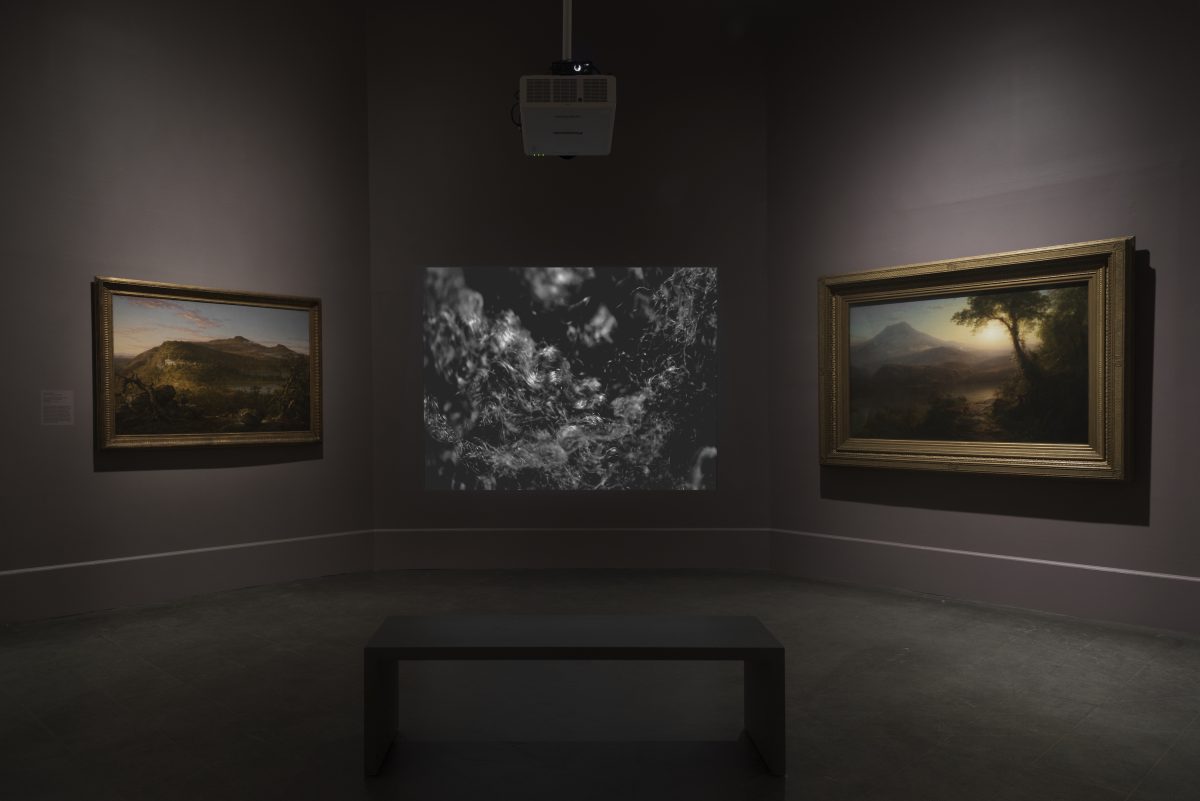
Lorraine O’Grady: Both/And has set the Brooklyn Museum ablaze with the radical gestures and eccentric poetics of an incomparable artist. O’Grady’s rebellious spirit has roused the mainstream art world for close to 50 years, and this exhibition is no exception.
Displaying hundreds of artworks from throughout her career, as well as archival documents, the show is extraordinarily thorough. This curatorial rigor is in part thanks to O’Grady’s own meticulous archival practice and collaboration with curators Aruna D’Souza, Catherine Morris, and Jenée-Daria Strand. These efforts coalesce as an exhibition that historicizes O’Grady as a prodigious figure of the conceptual, feminist, and Black American avant-garde, while simultaneously encouraging the viewer to enter the artist’s world and ponder her radical lessons.

The titular focus is the philosophical notion that undergirds O’Grady’s practice. Both/And thinking posits a refusal of either/or framework that is endemic to the West. In disavowing binaristic thinking, we can instead dwell on the nuance of the world’s disarray and uncertainty.
The exhibition is organized by O’Grady’s numerous bodies of work and begins in the 4th floor galleries, in the Sackler Center for Feminist Art. The first of these groupings I encountered was the Cutting Out the NY Times series, yielding a captivating experience of being absorbed by O’Grady’s collaged news clippings and her concrete poetry that is nevertheless replete with humorous statements and invigorating calls to action. O’Grady appropriates a purportedly objective source and reconfigures it into speculative poetics. “This could be… the permanent rebellion… that lasts a lifetime” and “Come out, come out, wherever you are,” among other scattered stanzas, are the bold outcomes of experimenting with the written word.

After reading O’Grady’s poems with great pleasure, I find myself drawn to the photography. Series such as Art is… are installed in a grid-like fashion, inviting a more linear viewing experience than the scattered collage-poems. A Black girl points through a gold frame as she takes part in the 1983 African American Day Parade in Harlem, where O’Grady brought gold frames and her camera to capture the rapturous delight of Black joy, affirming the artfulness of communal celebration. Though she sometimes works in solitude, O’Grady is an innovator whose work is always grounded in the experiences and aspirations of her community.
Yet, her loyalty and solidarity do not stop her from placing the Black art world under loving scrutiny. Mounted on a platform is a relic from her legendary 1980 performance — the white gloved dress of “Mlle Bourgeoise Noire.” In 1980, O’Grady strutted into Just Above Midtown Gallery, performing the avatar of a Black beauty queen and demanding that, “BLACK ART MUST TAKE MORE RISKS!” and “NOW IS THE TIME FOR AN INVASION!” The dress made of white gloves, hanging on a tan-skinned mannequin, now symbolizes O’Grady’s radical critique of elitism and complicity in the art world, and her own relatively privileged, middle class upbringing.

In the Ancient Egyptian gallery, “Miscegenated Family Album” (1980/1994) is an arrangement of portraits of O’Grady’s late sister Devonia Evangeline O’Grady juxtaposed with photographed sculptural portraits of Ancient Egyptian Queen Nefertiti. It is sensational to witness the visual intimacies of the sub-Saharan African diaspora with Ancient Egypt, especially in the Brooklyn Museum where the massive Ancient Egyptian collection remains segregated from the African arts department due to widespread historical revisionism that still separates North Africa from the rest of the continent.
In the American art gallery, a single video, “Landscape (Western Hemisphere)” (2010-2011) loops a close-up of O’Grady’s Black curly hair, nestled between Frederic Church and Thomas Cole’s Manifest Destiny paintings of empty, picturesque landscapes that are ultimately a matter of propaganda for Westward expansion/Native American land dispossession. What does it mean to draw a parallel between Black hair and “unconquered land”? Perhaps it is the unruliness of nature — roaming mountains and bountiful curls — or the sense of impending doom, as Black hair is still denigrated and Native American land and ways of life still dispossessed.

Yet, the most striking installation is that of O’Grady’s recent series, Announcement of a New Persona (2020) in the European art gallery lining the museum’s bright and spacious Beaux-Arts Court. Here, we find O’Grady as another avatar, this time a Medieval knight. The artist adorns her European knight costume with a palm tree, presumably alluding to her Caribbean heritage, and disrupting the eurocentricity of the gallery space. In one photograph she holds a sword horizontally, appearing almost poised to puncture the 19th century Auguste Rodin nude sculpture towering nearby. From “Mlle Bourgeoise Noire” to the Caribbean-inflected medieval knight, O’Grady’s performances and self-portraits explore a vast historic, gendered, and racialized range — avowing the fluidity of subjectivity and adorned presentations of the self.
O’Grady’s desire for “both/and” thinking pushes away from rigidity and pulls closer toward an expansive vision of Black feminism, subjectivity, and cultural production as sites of infinite possibility. Heeding her insight, this is one such way to grapple with the jaded feelings many of us have toward an art world in which major retrospectives for Black women artists are so unimaginably belated. The both/and model is a guiding principle for our ambivalence: it is both profoundly invigorating to revel in O’Grady’s radiant works gathered in such a monumental retrospective and upsetting that it is so long overdue.

Lorraine O’Grady: Both/And continues through July 18, 2021 at Brooklyn Museum, (200 Eastern Parkway, Crown Heights, Brooklyn). The exhibition is curated by Catherine Morris, Aruna D’Souza, and Jenée-Daria Strand.
0 Commentaires